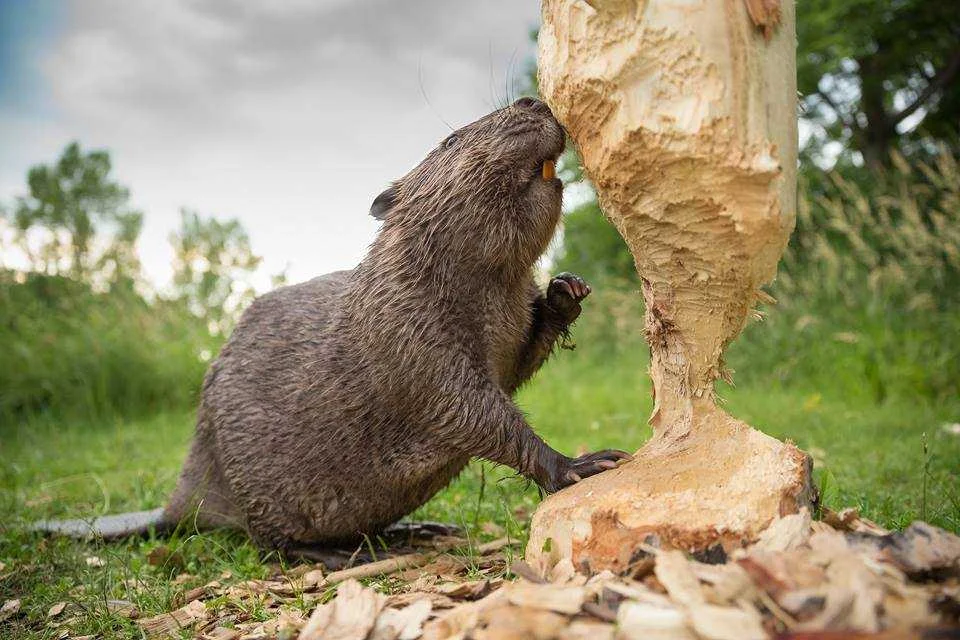Beavers
- Last Updated:

We can safely assume human kind is renowned for its knowledge of architecture and structure, but are humans the only living beings that construct houses, buildings and other structures? Absolutely not! Animals not only construct houses but also construct other complex structures. In fact, much of humans’ expertise in architecture can even be said to be inspired by them. One such marvel is the creation of dams by this smart creature called Beaver. Beaver dams are such elaborate structures that they are picked up by satellite imagery and they even regulate the temperature of the region. Let’s dive in further!
Beavers are semi-aquatic rodents that primarily inhabit the Northern Hemisphere. They are the world’s second largest rodent species and are just under 2 feet tall. They build dams, which are structures built on rivers or streams to hold water back.
I am Nature’s Architect
Humans use dams to control flooding, irrigate fields and generate electricity. Beavers build dams to protect themselves from predators, as they are most at risk on land. Very similar to how humans-built forts, Beavers build lodges with massive moats to protect themselves and even to catch prey. They live in dome shaped houses called lodges within the ponds created by their dams. These houses can only be accessed by an entrance that is underwater, thus helping the Beavers to escape from bears and wolves. They also prepare for the winter by storing food inside and keeping warmth inside.
Beavers build dams in medium sized streams located in heavily wooded areas. Their favored type of stream is characterized by a soft, muddy bottom, and they employ a combination of vegetation, mud, and sticks to construct a diminutive bank along the stream’s edge. Beavers shape logs of wood by chewing into them to create sturdy sticks that hold up their structures.

While a lone beaver’s task takes several days to finish making a dam, beavers can build dams really fast, some even building them overnight. Their dams are usually just 2 meters long.
Humans use dams to control flooding, irrigate fields and generate electricity. Beavers build dams to protect themselves from predators, as they are most at risk on land. Very similar to how humans built forts, Beavers build lodges with massive moats to protect themselves and even to catch prey. They live in dome shaped houses called lodges within the ponds created by their dams. These houses can only be accessed by an entrance that is underwater
thus helping the Beavers to escape from bears and wolves. They also prepare for the winter by storing food inside and keeping warmth inside.
Beavers build dams in medium sized streams located in heavily wooded areas. Their preference is for streams that have soft, muddy bottoms and they utilize vegetation, mud, and sticks to construct a modest embankment on the edge of the stream. Beavers shape logs of wood by chewing into them to create sturdy sticks that hold up their structures.
A GREEN SEA SLUG THAT BEHAVES LIKE A LEAF
Elysia Chlorotica, one of the most incredible creatures on earth, is a sea slug that looks like a bright green leaf. The slug is 5cm long and is found along the East Coast of North America. It is generally found at shallow depths in salt and tidal marshes, shallow creeks and pools.
This animal is a mixotroph, which implies that it has the ability to both ingest food like animals and generate its own food through photosynthesis, similar to plants. The sea slug can go for a year without eating, during which time it lives like a plant.
How is Elysia able to produce its own food?
The green sea slug gets its ability to photosynthesize by eating algae. While eating algae, it pokes into the algal cells with specialised pointy teeth called radula, using which it sucks the cell empty and digests most of the algae. The chloroplasts of the algae however end up remaining intact.
Chloroplasts are the organelles in plants that enable them to convert sunlight into food through photosynthesis. The epithelial cells lining Elysia’s digestive system, which extends throughout its flat body, are adorned with attached chloroplasts. This phenomenon of getting chloroplasts from algal food is called kleptoplasty. The presence of these chloroplasts help the sea slug camouflage and make food by photosynthesis.
Elysia can live up to 9 months without having to eat any food. They do this by getting their nutrition through photosynthesis, using the chloroplasts from the algae they have eaten. These creatures have a mechanism to avoid starvation until they locate additional algae to feed on.
The slugs remain green coloured as long as their body holds the chloroplasts from the algae. When the body runs out of it, the slug becomes its original grey colour. The Elysia’s leaf-like structure helps it be more efficient at photosynthesis and camouflage better.
Shop: Kids Punnagai


